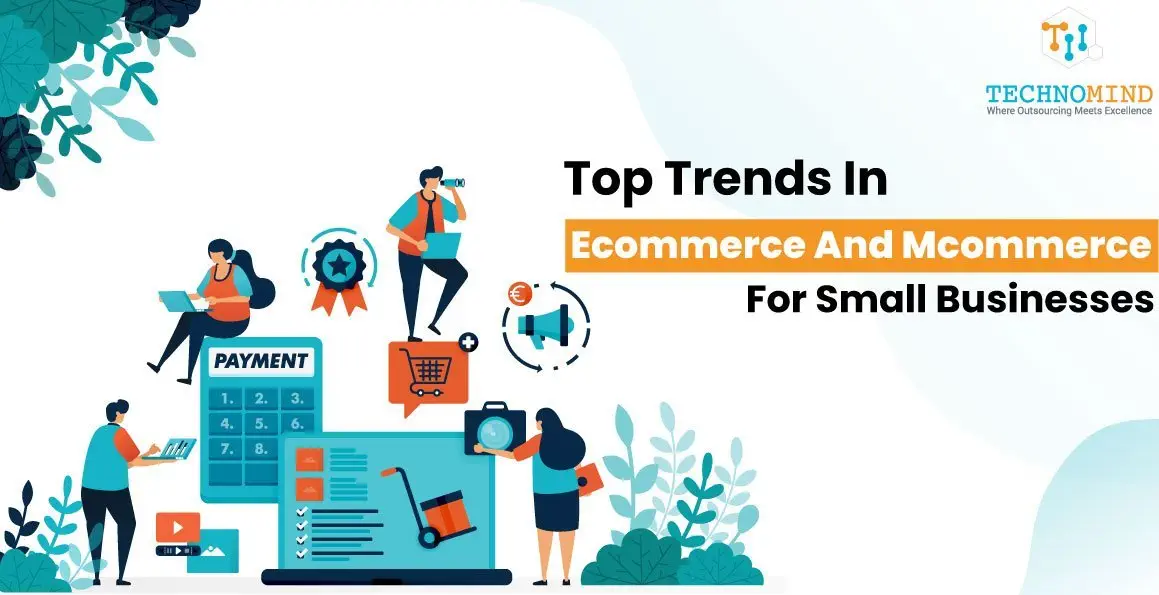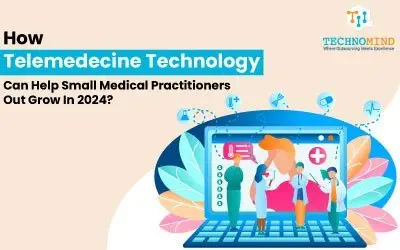Blog
Top Trends in eCommerce and mCommerce for Small Businesses
The year 2023 has witnessed an unprecedented surge in digital transactions, reshaping the way small businesses engage with their customers. According to recent statistics, the global eCommerce market has seen remarkable growth, with an increasing number of consumers turning to online platforms for their shopping needs.
While welcoming a new year, the question arises: How can small businesses leverage these evolving trends to carve their niche in this growing pattern of digital commerce?
In this article, we will explore the top trends that will define the eCommerce and mCommerce business for small enterprises in 2024.
What is eCommerce and mCommerce For Small Businesses?
Before getting into the trends, let’s understand the basics.
eCommerce refers to buying and selling goods and services over the internet. On the other hand, mCommerce, or mobile commerce, specifically focuses on transactions conducted through mobile devices like smartphones and tablets.
For small businesses, embracing these digital avenues opens up new possibilities to reach a broader audience and thrive in the competitive market.
What is the difference between eCommerce and mCommerce?
It’s critical to understand that, while analyzing the subtle differences between Explore the latest eCommerce and mCommerce trends shaping small businesses. Stay ahead with Technomind Software’s insights for digital growth your business., these phrases refer to different aspects of the digital commerce space, each having special traits and ramifications for small enterprises.
eCommerce, encompasses a broad spectrum of online transactions conducted over the internet. This expansive category includes purchases made through desktops, laptops, or any device connected to the web.
Small businesses entering the eCommerce arena typically establish an online presence through dedicated websites or third-party platforms, enabling them to showcase their products or services to a global audience. The flexibility inherent in eCommerce allows consumers to make purchases at any time, providing businesses with a continuous storefront and eliminating geographical limitations. This inclusivity fosters a diverse customer base and opens avenues for growth and expansion.
On the other hand, mCommerce, or mobile commerce, is a specialized subset that revolves around transactions carried out specifically on mobile devices such as smartphones and tablets. The key differentiator lies in accessibility and convenience.
With the proliferation of smartphones, consumers increasingly prefer the ease of browsing and purchasing directly from their mobile devices.
For small businesses, this means tailoring their digital strategies to accommodate the unique demands of mobile users. Whether through mobile-optimized websites or dedicated applications, mCommerce caters to an on-the-go clientele, emphasizing a seamless and efficient user experience.
Growing Future of eCommerce and mCommerce
The trajectory of eCommerce and mCommerce Trends points towards an immensely promising future, with statistical data painting a vivid picture of the phenomenal growth witnessed in recent years. According to Statista, the global eCommerce market is projected to reach a staggering $4.9 trillion in 2024, showcasing a substantial increase from previous years. This exponential growth is attributed to the widespread adoption of online shopping, driven by factors such as convenience, an extensive product variety, and the ease of comparison shopping.
Small businesses, in particular, stand to benefit from this upward trend as they harness the power of digital platforms to reach a global customer base and compete on a level playing field with more established counterparts.
Top Trends in eCommerce and mCommerce in 2024
Growing Trend of Mobile Shopping:
- Mobile-Centric Platforms:Small businesses are increasingly developing mobile-centric platforms, ensuring responsive design and user-friendly interfaces for a seamless shopping experience on smartphones.
- App Optimization:Recognizing the surge in app usage, businesses are investing in optimizing mobile applications, offering exclusive deals, and enhancing functionality to attract and retain mobile shoppers.
- Mobile-First Marketing:Tailored marketing strategies specifically targeting mobile users, including SMS campaigns, push notifications, and mobile-exclusive promotions, are becoming integral for small businesses.
- Geo-Targeting for Localization:Utilizing geo-targeting features to provide location-based offers, discounts, and product recommendations, creating a personalized experience for mobile shoppers.>
Voice Search for Voice Shopping:
- Integration of Voice Assistants:Small businesses are integrating voice-activated assistants like Siri, Alexa, and Google Assistant into their platforms, allowing users to search for products and complete transactions using voice commands.
- Voice-Enabled Product Discovery:Implementing voice-enabled product discovery features, enabling users to inquire about product details, availability, and prices through natural language interactions.
- Voice-Based Promotions: Offering exclusive promotions for voice-activated purchases, incentivizing users to explore and adopt this hands-free and convenient shopping method.
- Enhanced Voice Security:Ensuring secure voice transactions with advanced authentication methods to build trust among consumers and mitigate concerns related to voice-activated shopping
Social Media’s Growing Role in Social Commerce:
- Shoppable Posts and Ads: Integrating shoppable posts and ads on social media platforms, allowing users to discover and purchase products seamlessly without leaving the platform.
- In-App Checkout:Enabling in-app checkout features on social media platforms, reducing friction in the purchasing process and capitalizing on impulse buying behavior.
- User-Generated Content for Influence: Leveraging user-generated content for social commerce, encouraging customers to share their experiences and recommendations, influencing potential buyers.
- Live Shopping Experiences: Hosting live shopping events and product launches on social media, providing an interactive and real-time shopping experience for users.
AI for Personalized Experience:
- Behavioral Analysis: Implementing AI algorithms for analyzing user behavior, preferences, and purchase history to provide personalized product recommendations.
- Dynamic Pricing Strategies:Using AI-driven dynamic pricing strategies to offer personalized discounts, promotions, and pricing structures based on individual customer profiles.
- Predictive Analytics:Employing predictive analytics to anticipate customer needs, optimize inventory, and enhance the overall customer journey.
- Chatbot Personalization: Integrating AI-driven chatbots that offer personalized assistance, product recommendations, and tailored information based on individual customer queries.
VR and AR for Next-Level Shopping Experience:
- Virtual Try-On Experiences: Introducing virtual try-on experiences through AR applications, allowing customers to virtually test products like clothing, accessories, and even furniture before making a purchase.
- AR Product Visualization:Using AR to enhance product visualization, enabling customers to see how products will look in their real-world environment before deciding to buy.
- VR Storefronts:Creating immersive VR storefronts that simulate a physical shopping experience, providing a virtual environment where customers can explore products in a more engaging way.
- Interactive Product Demos: Leveraging AR for interactive product demonstrations, allowing users to engage with products in a three-dimensional space and gain a deeper understanding of their features.
Conversational Commerce with AI Chatbots and ChatGPT:
- Real-Time Customer Support:Employing AI chatbots for real-time customer support, addressing queries, providing information, and assisting users throughout their shopping journey.
- Order Tracking and Updates:Integrating chatbots to provide order tracking and updates, keeping customers informed about the status of their purchases.
- Natural Language Processing: Implementing natural language processing capabilities in chatbots to understand and respond to user queries in a conversational and context-aware manner.
- Cross-Sell and Up-Sell Recommendations:Utilizing chatbots to offer cross-sell and up-sell recommendations based on customer preferences and shopping patterns
Omnichannel Customer Engagement Approach:
- Seamless Cross-Platform Experience:Ensuring a seamless experience for customers across multiple platforms, including websites, mobile apps, and physical stores, creating a consistent brand experience.
- Integrated Loyalty Programs:Integrating loyalty programs that span various channels, rewarding customers for interactions and purchases made both online and offline.
- Unified Customer Data:Centralizing customer data to create a unified view across channels, enabling businesses to better understand and anticipate customer needs.
- In-Store Pickup and Returns:Offering options for in-store pickup and returns for online purchases, bridging the gap between online and offline shopping experiences.
Subscription Commerce:
- Customizable Subscription Plans:Providing customers with customizable subscription plans, allowing them to choose products, delivery frequencies, and payment schedules that suit their preferences.
- Exclusive Access and Benefits: Offering subscribers exclusive access to new products, early releases, or special promotions, incentivizing enrollment in subscription programs.
- Personalized Subscription Boxes: Curating personalized subscription boxes based on customer preferences, creating a tailored and exciting unboxing experience.
- Flexible Subscription Management: Implementing user-friendly interfaces for managing subscriptions, allowing customers to easily modify, pause, or cancel their subscription plans.
Mobile Payments and Credit Facilities:
- Diverse Mobile Payment Options: Accepting a variety of mobile payment options, including digital wallets, mobile banking apps, and contactless payments, to cater to diverse customer preferences.
- Secure Mobile Transactions:Implementing robust security measures for mobile transactions, ensuring the safety of customer data and fostering trust in mobile payment processes.
- Credit Facilities and Installment Plans:Offering credit facilities and installment plans for high-ticket items, making purchases more accessible and accommodating various budget constraints.
- Integration with Loyalty Programs:Integrating mobile payment options with loyalty programs, providing additional incentives and rewards for customers who choose mobile payment methods.
Single-Click Shopping Experience:
- One-Click Checkout:Streamlining the checkout process to a single-click, reducing friction and simplifying the purchase journey for customers.
- Saved Payment and Shipping Information:Allowing users to save their payment and shipping information for future purchases, eliminating the need to re-enter details with each transaction.
- Guest Checkout Options:Offering guest checkout options for users who prefer a quick, one-time purchase without creating an account.
- Instant Purchase Confirmation: Providing instant purchase confirmation messages and receipts, assuring customers that their transactions have been successfully completed.
Cookieless Retargeting:
- Contextual Targeting:Shifting towards contextual targeting methods that consider the content and context of the user’s current online experience, rather than relying on tracking cookies.
- First-Party Data Utilization:Emphasizing the use of first-party data collected directly from customers to deliver personalized ads and recommendations.
- Privacy-Centric Advertising: Communicating privacy-centric approaches to customers, assuring them of data protection measures and respecting their online privacy.
- Adaptive Retargeting Strategies: Implementing adaptive retargeting strategies that adjust to evolving privacy regulations and user expectations, ensuring a seamless advertising experience.
Conclusion
eCommerce and mCommerce Trends for small businesses in 2024 is marked by dynamic trends that promise both challenges and opportunities. By adopting these trends, small businesses can not only stay competitive but also carve out unique and memorable experiences for their customers. The fusion of innovation, convenience, and adaptability positions small enterprises at the forefront of the digital evolution, ensuring a promising future in online commerce.
How Telemedicine Technology can help Small Medical Practitioners out grow in 2024?
Everyone wants to grow their business in recent times and without technology it is not possible. That’s an undeniable truth. Big medical giants and…
How Innovative Technologies Powering Startup Growth in 2024?
Startups are like the cool trendsetters of the digital playground. With their growing usability and importance in business, smart tech, fancy marketing tricks, and social media magic…
How Startups Are Changing Traditional Industries with Technology Adoption?
Who can deny that traditional industries are getting a shake-up from technology startups. These startups, armed with new ideas and high-tech tools…





0 Comments